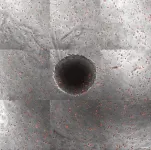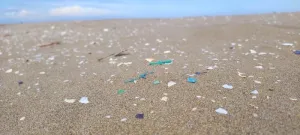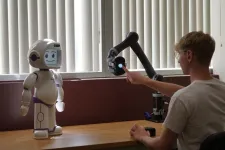(Press-News.org) Even though they’re the largest animals on earth, whales remain difficult to track. So experts often turn to historical whaling data to inform current research. A dataset maintained by the International Whaling Commission (IWC) contains detailed information on commercial whale catches — more than 2.1 million records, predominantly from 1880 until the IWC banned whaling in 1986. Yet for researchers, distilling that data can prove its own challenge.
A team at the University of Washington has created an online interactive map called WhaleVis, which lets whale researchers visualize the IWC’s data on global whale catches and whaling routes. From this, researchers can estimate the animals’ spatial distribution and the effort whalers put into hunts.
By comparing historical data and its trends with current information, scientists can better understand how populations of whales have changed over time, where they’ve been, and how to better protect those still living.
The UW team presented its research Oct. 25 at the IEEE VIS conference in Melbourne (Narrm), Australia. The tool is online, but users must have permission from the IWC to access it.
“Scientific data is a really important aspect of big data, but scientists all over the world have access to completely different hardware and software. Maybe they can’t use big servers to process huge data sets quickly,” said senior author Leilani Battle, a UW assistant professor in the Paul G. Allen School of Computer Science & Engineering. “So when creating WhaleVis we had to ask: How do we design a tool that can visualize millions of data points, but that doesn’t rely on super beefy servers?”
The team approached this in a couple of ways. First, instead of trying to render more than 2 million points on a global map at once, taxing the computer processor and creating a “hairball visualization” — an illegible mess of lines and dots — the researchers aggregated whale catches in clusters. One large blue dot at South Georgia island in the South Atlantic Ocean, for example, signifies 130,611 whale catches, most of them fin whales. As researchers continue to develop the tool, they’ll allow users to zoom in on parts of the map to access greater detail.
Second, they built the tool for web browsers, instead of as a standalone app, to make it function on different computing platforms.
“It was important to make this data accessible so it can easily be used to generate actionable insights,” said lead author Ameya Patil, a UW doctoral student in the Allen School. “Tools like this make information more tangible and comprehensible.”
WhaleVis came about through the UW’s Computing for the Environment, an initiative bringing together computer and climate scientists to collaborate. Trevor Branch, a co-author on the paper and UW professor in the School of Aquatic and Fishery Sciences, had been working with the IWC data set and wanted help visualizing it, especially in such a way that would estimate how much effort had gone into each whale catch. Battle and Patil were seeking a project that combined environmental science with data visualization, and the IWC data set fit the bill.
“Being able to visualize the data like this helps us answer a huge number of questions,” Branch said. “For example, it is difficult to separate two of the subspecies of blue whales — massive Antarctic blue whales and pygmy blue whales that are about 20 feet shorter. Visualizing the expeditions that caught big whales versus pygmies lets us clearly and quickly see the boundary between those two subspecies.”
In its current iteration, WhaleVis uses the density of expeditions in certain areas to let scientists approximate the effort whalers put into each hunt. If researchers can quantify this effort — that is, the time and distance between catches on these expeditions — it gives a better sense of size, density and location of historical whale populations.
In the future, the team plans to refine the methods of estimating whalers’ efforts, normalizing for factors such as time between catches on each expedition. The researchers also intend to add interactive prediction modeling for different scenarios and to apply the methods used on WhaleVis to other animal populations.
“From a researcher point of view, what’s already online is very, very cool,” Branch said, “and way past anything that’s been available up to now. Only when you start playing with the data in a nice visualization do you discover some of the anomalies and surprises in it.”
Zoe Rand, a doctoral student in quantitative ecology and resource management, was also a co-author on this paper. This research was funded by the University of Washington Computing for the Environment Initiative and the National Science Foundation.
For more information, contact Patil at ameyap2@cs.washington.edu, Battle at leibatt@cs.washington.edu, and Branch at tbranch@uw.edu.
END
WhaleVis turns more than a century of whaling data into an interactive map
2023-11-15
ELSE PRESS RELEASES FROM THIS DATE:
Forget social distancing: House finches become more social when sick
2023-11-15
Social distancing when sick has become second nature to many of us in the past few years, but some sick animals appear to take a different approach. A new study of house finches led by Marissa Langager, a Ph.D. student in the Department of Biological Sciences in the College of Science, uncovered a surprising result. Unlike other social animals who passively or actively isolate themselves when sick, this gregarious backyard bird species gravitates toward healthy flock mates when they are sick, even ...
Microorganisms living in gastrointestinal tracts may foretell diagnoses of debilitating diseases including Alzheimer’s and Parkinson’s
2023-11-15
Nov. 15, 2023
Media Contacts:
Emily Gowdey-Backus, director of media relations
Nancy Cicco, assistant media relations
The trillions of microorganisms living in gastrointestinal tracts may foretell diagnoses of debilitating diseases including Alzheimer’s and Parkinson’s
Microbiome may hold clues that could revolutionize diagnosis and treatment
Researchers at UMass Lowell’s Zuckerberg College of Health Sciences are exploring how the gut microbiome contributes to the risk of Parkinson’s and Alzheimer’s diseases. This research could lead to earlier detection and new treatments for people with those diseases, which ...
Longitudinal characterization of behavioral, morphological and transcriptomic changes in a tauopathy mouse model
2023-11-15
“Here we used the PS19 (P301S) mouse model of tauopathies to characterize longitudinal changes in behavioral, morphological, and transcriptomic levels.”
BUFFALO, NY- November 15, 2023 – A new research paper was published on the cover of Aging (listed by MEDLINE/PubMed as "Aging (Albany NY)" and "Aging-US" by Web of Science) Volume 15, Issue 21, entitled, “Longitudinal characterization of behavioral, morphological and transcriptomic changes in a tauopathy mouse model.”
Neurodegenerative ...
Two Sandia National Labs researchers elected associate fellows for aerospace contributions
2023-11-15
ALBUQUERQUE, N.M. — Two Sandia National Laboratories employees will soon join the American Institute of Aeronautics and Astronautics class of 2024 as associate fellows.
“This distinguished group of professionals has made significant and lasting contributions to the aerospace profession,” said AIAA President and Sandia Deputy Laboratories Director Laura McGill. “They exemplify expertise and dedication to excellence in advancing their specific technical disciplines. They are truly shaping the future of aerospace, and we are proud of their achievements.”
Michael Ross
Michael Ross was recognized for his work in ...
UTHealth Houston researcher receives NIH subcontract to study effects of integrated palliative care on Parkinson’s, related dementia
2023-11-15
A five-year, $3.9 million grant to study the effects of integrated palliative care on health service outcomes and disparities in Parkinson’s disease and Parkinson’s disease dementia has been awarded to UTHealth Houston and other institutions by the National Institute of Neurological Disorders and Stroke, part of the National Institutes of Health.
As part of the grant, Adriana Pérez, PhD, professor in the Department of Biostatistics and Data Science with UTHealth Houston School of Public Health ...
Shape-shifting immune cells offer new insights into cancer immunotherapy
2023-11-15
Macrophages, a type of white blood cell that can destroy invading pathogens, have an innate ability to infiltrate tumor cells, making them a potentially important tool in treatments that use transplanted cells to fight disease, known as cell therapy. In the lab, macrophages show a lot of promise in treating cancer but so far, clinical trials have been a disappointment and biologists are trying to figure out why.
But what if it’s not a biological problem?
In a recent paper, researchers from the Harvard John A. Paulson School of Engineering and Applied ...
All aquatic species in river mouths are contaminated by microplastics
2023-11-15
All aquatic species in the river mouths flowing into the Mediterranean Sea and Atlantic Ocean are contaminated with microplastics, with molluscs being the most affected due to their ability to filter water. Rivers are one of the main sources of pollution by microplastics (5 to 0.0001 mm in size) and nanoplastics (smaller than 0.0001mm) in the oceans. Estuaries, as transition zones between rivers and the sea, are major hotspots for the accumulation of these particles, which are retained in sediments. They pose a threat to aquatic ecosystems given their ability to capture harmful chemicals from the surrounding environment, ...
Smaller hippocampus linked to cognitive decline
2023-11-15
MINNEAPOLIS – With the rise of new drugs that can target the amyloid-beta plaques in the brain that are an early sign of Alzheimer’s disease, new ways are needed to determine whether memory loss and thinking problems are due to Alzheimer’s disease or another neurodegenerative disorder. A new study published in the November 15, 2023, online issue of Neurology®, the medical journal of the American Academy of Neurology, shows that shrinkage in the hippocampus area of the brain is associated with cognitive decline, even in people who don’t have amyloid plaques in the brain. The hippocampus plays a role in memory.
“These results suggest ...
ECOG-ACRIN and PrECOG announce multiple presentations at the American Society of Hematology (ASH) 2023 annual meeting
2023-11-15
Researchers with the ECOG-ACRIN Cancer Research Group (ECOG-ACRIN) and PrECOG, LLC, will present six oral and three poster presentations at the 65th American Society of Hematology (ASH) Meeting & Exposition, occurring in San Diego, California and virtually December 9-12, 2023. The presentations focus on treatments for acute leukemias and lymphomas.
Among the data are the promising results of the phase 2 PrE0405 trial, which evaluated bendamustine, rituximab, and venetoclax for the initial treatment of mantle cell lymphoma in older patients. Other ...
Use it or lose it: New robotic system assesses mobility after stroke
2023-11-15
Embargoed: Not for Release Until 2:00 pm U.S. Eastern Time Wednesday, 15 November 2023
Stroke is a leading cause of long-term disability worldwide. Each year more than 15 million people worldwide have strokes, and three-quarters of stroke survivors will experience impairment, weakness and paralysis in their arms and hands.
Many stroke survivors rely on their stronger arm to complete daily tasks, from carrying groceries to combing their hair, even when the weaker arm has the potential to improve. Breaking this habit, known as “arm nonuse” or “learned nonuse,” can improve strength and prevent injury.
But, determining how much ...









